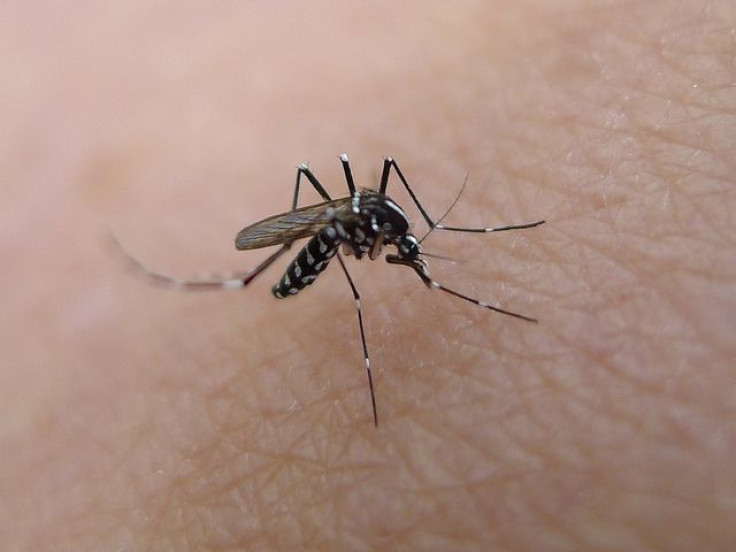The Science Of Mosquito Bites: Pesky Insects Use 3 Senses To Feed On Human Blood

With summer upon us, we’ll be spending more and more time outdoors, basking in the warm sun, sitting by the beach, going to the ballpark, or grilling in the backyard. Summer is also the perfect time for everyone’s favorite bloodsucker, the mosquito, to come out and play.
We’ll do anything to avoid getting mosquito bites: spray insect repellent, light citronella candles, hang bug zappers, and more. But eventually the bug spray wears off, the citronella candle burns out, and the bug zapper is deemed to be totally lame by your kids. So, what do you do to avoid mosquito bites? Hide inside? That’s no fun. Craft an elaborate cage that keeps bugs out for you and your loved ones? By the time you’re finished, summer will be over.
Unfortunately, new research has shown that there isn’t much you can do to avoid being the target of a mosquito. The study, published by researchers in the laboratory of Michael Dickinson, the Esther M. and Abe M. Zarem Professor of Bioengineering, shows that mosquitoes have three sensors — olfactory, visual, and thermal — that detect where exactly your delicious blood is.
When an adult female mosquito wants a blood meal for its young, it searches out a host. Since we have a lot of blood coursing through our veins, we’re a perfect target. We also emit carbon dioxide gas with every breath (and through other means), which the mosquito is highly attracted to. The mosquito also tracks our body heat, to make sure our blood is still warm, and uses its eyes to make sure we definitely are what the other sensors said we are.
The study set out to decipher how exactly the mosquitoes use all three of those sensors to seek out their next meal.
Researchers released hungry, mated female mosquitoes into a wind tunnel to find out how and when the mosquito uses each of its sensors.
One experiment released a high concentration plume of carbon dioxide that mimicked a human’s exhale. For the control, they released a similar plume but with a lower level of carbon dioxide. Then they released 20 mosquitoes and tracked their movements with video cameras and 3D tracking software. The mosquitoes were very attracted to the concentrated plume of carbon dioxide, but were less interested in the control plume.
"In a previous experiment with fruit flies, we found that exposure to an attractive odor led the animals to be more attracted to visual features," said Floris van Breugel, a postdoctoral scholar in Dickinson's lab and first author of the study. "This was a new finding for flies, and we suspected that mosquitoes would exhibit a similar behavior. That is, we predicted that when the mosquitoes were exposed to CO 2 , which is an indicator of a nearby host, they would also spend a lot of time hovering near high-contrast objects, such as a black object on a neutral background."
Van Bruegel and his team tested this by adding a black object to the previous experiment involving the two plumes of carbon dioxide. They found that the high concentration of carbon dioxide and the high contrast, dark object both attracted the mosquitoes, while they ignored the object in the control plume test.
After figuring out how mosquitoes used smell to find a host, the researchers moved on to the mosquitoes’ thermal sensors. "Obviously, we know that if you have an object in the presence of a CO2 plume — warm or cold — they will fly toward it because they see it," van Brugel said. "So we had to find a way to separate the visual attraction from the thermal attraction."
The researchers took two glass containers and coated them with a clear substance that could be heated to any temperature. They set the glass containers on the floor of the wind tunnel, turned one glass container up to 37 degrees Celsius and left the other at room temperature, pumped in some carbon dioxide, and watched the mosquitoes.
They found that the mosquitoes were more interested in the warmer glass container but that the preference to warmth wasn’t dependent on the presence of the carbon dioxide.
After learning all this about mosquitoes, the researchers were able to come up with a model of how a mosquito finds a host over different distances. At 10 to 50 meters, a mosquito locks onto your carbon dioxide emissions. From 5 to 15 meters, the mosquito locks onto you visually and as it gets even closer, less than a meter, it can detect your body heat.
All of this information is great for scientists and great for manufacturers of anti-mosquito traps and sprays. It’ll help them come up with better instruments to combat the pesky insects. But what does that mean for us, regular humans who don’t want to get bitten every time we step outside in the summer? The results aren’t very good.
"Even if it were possible to hold one's breath indefinitely," the authors note toward the end of the paper, "another human breathing nearby, or several meters upwind, would create a carbon dioxide plume that could lead mosquitoes close enough to you that they may lock on to your visual signature. The strongest defense is therefore to become invisible, or at least visually camouflaged. Even in this case, however, mosquitoes could still locate you by tracking the heat signature of your body. … The independent and iterative nature of the sensory-motor reflexes renders mosquitoes' host seeking strategy annoyingly robust."
Source: van Brugel F, Dickinson M, Riffell J, Fairhall A. Mosquitoes Use Vision to Associate Odor Plumes with Thermal Targets. Current Biology. 2015.



























